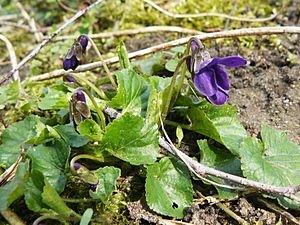Appalachian blue violet facts for kids
Quick facts for kids Appalachian blue violet |
|
|---|---|
 |
|
| Conservation status | |
| Scientific classification | |
| Genus: |
Viola (plant)
|
| Species: |
appalachiensis
|
| Synonyms | |
|
|
Viola appalachiensis, also called the Appalachian blue violet, is a special kind of violet. It is also known as Appalachian violet or Henry's violet. This plant grows naturally in the Appalachian Mountains in the Eastern United States.
Appalachian Blue Violet
Where it Grows
The Appalachian blue violet likes to grow in rich, moist forests. You can find it in mountain coves and along stream banks. Sometimes, it even grows in mowed areas like forest roads.
Its natural range stretches from Pennsylvania down to North Carolina. It lives only within the Appalachian Mountains. This violet is very rare, meaning it is hard to find.
Some scientists think this violet is the same species as V. walteri. However, other scientists believe it is a unique species of its own.
What it Looks Like
This plant is a herbaceous plant. This means it has soft stems, not woody ones. It is also a perennial, so it lives for more than two years. It is an evergreen, keeping its leaves all year round.
The Appalachian blue violet can grow up to 10 centimeters (about 4 inches) tall. Its new stems first grow upwards. Then, they lie down and spread out, forming a mat. These stems can grow roots from their joints. The plant is mostly smooth, with very few hairs.
Its leaves grow alternately along the stem. Sometimes, the plant looks like it has no stem at all. Each leaf is shaped like a kidney. The edges of the leaves are slightly toothed or wavy. They have a few hairs near the edges.
The flowers of this violet have an irregular shape. They are blue with a white center. The first blooms appear in the middle of spring. They continue to flower into late spring. The part of the flower called the spur is much longer than it is wide. The side petals have tiny hairs, which is called being bearded.


